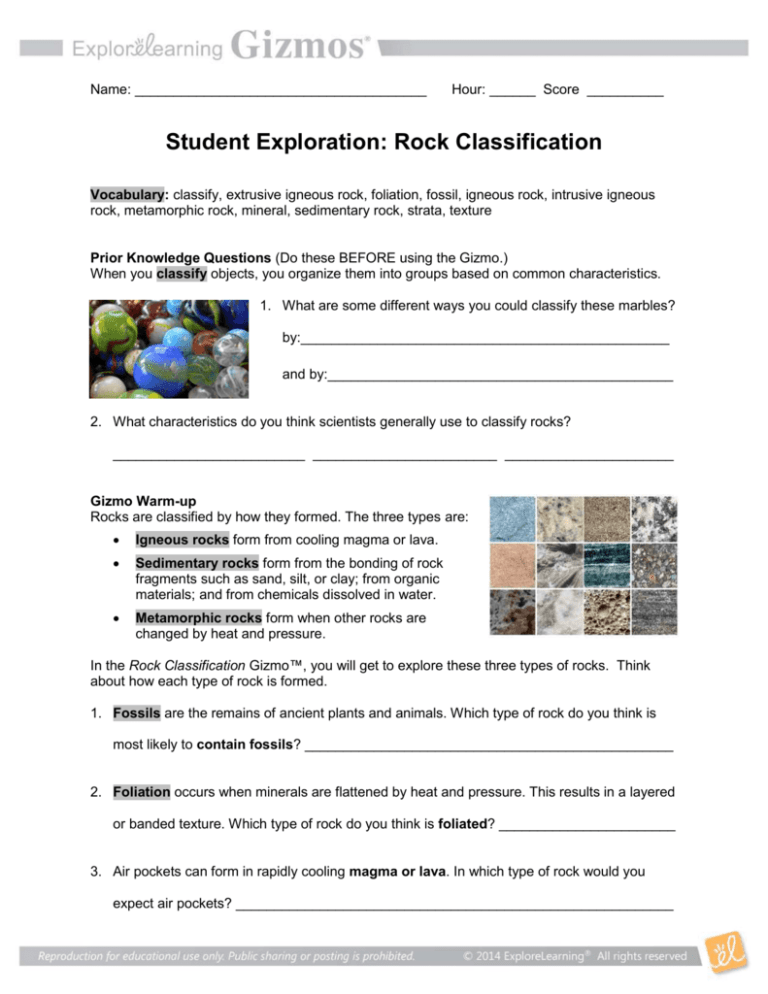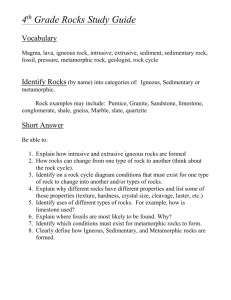Rock Classification
advertisement

Name: ______________________________________ Hour: ______ Score __________ Student Exploration: Rock Classification Vocabulary: classify, extrusive igneous rock, foliation, fossil, igneous rock, intrusive igneous rock, metamorphic rock, mineral, sedimentary rock, strata, texture Prior Knowledge Questions (Do these BEFORE using the Gizmo.) When you classify objects, you organize them into groups based on common characteristics. 1. What are some different ways you could classify these marbles? by:________________________________________________ and by:_____________________________________________ 2. What characteristics do you think scientists generally use to classify rocks? _________________________ ________________________ ______________________ Gizmo Warm-up Rocks are classified by how they formed. The three types are: Igneous rocks form from cooling magma or lava. Sedimentary rocks form from the bonding of rock fragments such as sand, silt, or clay; from organic materials; and from chemicals dissolved in water. Metamorphic rocks form when other rocks are changed by heat and pressure. In the Rock Classification Gizmo™, you will get to explore these three types of rocks. Think about how each type of rock is formed. 1. Fossils are the remains of ancient plants and animals. Which type of rock do you think is most likely to contain fossils? ________________________________________________ 2. Foliation occurs when minerals are flattened by heat and pressure. This results in a layered or banded texture. Which type of rock do you think is foliated? _______________________ 3. Air pockets can form in rapidly cooling magma or lava. In which type of rock would you expect air pockets? _________________________________________________________ Activity A: Classifying rocks Get the Gizmo ready: Click Reset. Introduction: You can classify rocks by examining characteristics such as texture. A rock’s texture is determined by the sizes, shapes, and positions of the grains that make up the rock. Goal: Classify rocks as igneous, sedimentary, or metamorphic. 1. Summarize: The three groups of rocks each have unique characteristics. For example, many igneous rocks have a texture of interlocking mineral crystals. Sedimentary rocks may have distinct layers of sediments, known as strata. To learn other characteristics of igneous, metamorphic, and sedimentary rocks, turn on Show common characteristics in the CHARACTERISTICS pane. In the table below, summarize the textures that will allow you to identify and classify these rock types. Rock type Characteristics Igneous Sedimentary Metamorphic 2. Classify: Select Name on the SIMULATION pane. Move your cursor over the rock pictures. Based on what you see, classify the rocks by dragging them into the correct box on the CHARACTERISTICS tab. Record your classifications (in pencil) in the table below. Rock type Rock names Igneous Sedimentary Metamorphic Click on Status to check your answers. If necessary, change your classifications of rocks on the Gizmo, and make any needed corrections to the table above. When you are done, click COPY SCREEN to take a screenshot, and then paste the image into a blank document. Activity B: Rock locations Get the Gizmo ready: Click Reset. Select the LOCATION tab. Introduction: Igneous rocks that form under Earth’s surface are called intrusive. Intrusive igneous rocks usually have large mineral grains because they form from magma that cools slowly. Igneous rocks that form above ground are extrusive. Extrusive igneous rocks have small mineral grains or no grains at all because they form from lava that cools quickly. Question: Where do different kinds of rocks form? 1. Label: Review how the different types of rock form. On the diagram at right, label where you would expect the following types of rock to form: extrusive igneous rocks intrusive igneous rocks metamorphic rocks sedimentary rocks Select Show classification names to check your labels. Correct any rock locations that you labeled incorrectly. 2. Classify: Drag the rocks from the SIMULATION pane to the correct positions on the LOCATION tab. Click on Status to check your placements. When you are done, click COPY SCREEN to take a screenshot, and then paste the image into your blank document. Which rocks did you classify as extrusive and intrusive igneous rocks? Extrusive: ___________________ ___________________ Intrusive: ___________________ ___________________ 3. Analyze: What features did you use to classify igneous rocks as extrusive or intrusive? _________________________________________________________________________ 4. Draw conclusions: Extrusive igneous rocks often have air pockets, but intrusive igneous rocks never do. Why do you think is this the case? _________________________________ _________________________________________________________________________ Label the Rock Cycle Diagram 1. 2. 8. 9. 3. 4. 7. 6. 5. Place the number of the process from the diagram next to each term below that correctly illustrates what has to happen to change from one substance to another Cooling ________ Melting ________ & _________ Heat & Pressure _________ & __________ Compaction & Cementing ________ Weathering and Erosion ________ _________ & ___________







